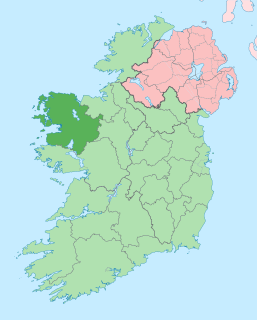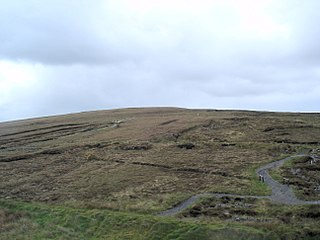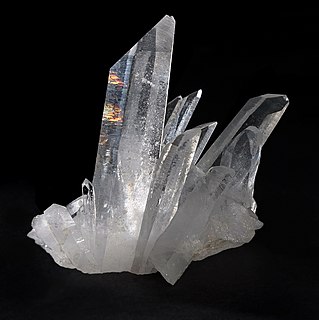
County Mayo is a county in Ireland. In the West of Ireland, in the province of Connacht, it is named after the village of Mayo, now generally known as Mayo Abbey. Mayo County Council is the local authority. The population was 130,507 at the 2016 census. The boundaries of the county, which was formed in 1585, reflect the Mac William Íochtar lordship at that time.

In Old World archaeology, Mesolithic is the period between the Upper Paleolithic and the Neolithic. The term Epipaleolithic is often used synonymously, especially for outside northern Europe, and for the corresponding period in the Levant and Caucasus. The Mesolithic has different time spans in different parts of Eurasia. It refers to the final period of hunter-gatherer cultures in Europe and Western Asia, between the end of the Last Glacial Maximum and the Neolithic Revolution. In Europe it spans roughly 15,000 to 5,000 BP; in Southwest Asia roughly 20,000 to 8,000 BP. The term is less used of areas further east, and not at all beyond Eurasia and North Africa.
In archaeology, lithic analysis is the analysis of stone tools and other chipped stone artifacts using basic scientific techniques. At its most basic level, lithic analyses involve an analysis of the artifact’s morphology, the measurement of various physical attributes, and examining other visible features.

Star Carr is a Mesolithic archaeological site in North Yorkshire, England. It is around five miles (8.0 km) south of Scarborough. It is generally regarded as the most important and informative Mesolithic site in Great Britain. It is as important to the Mesolithic period as Stonehenge is to the Neolithic period or Scandinavian York is to understanding Viking age Britain.

In archaeology, a blade is a type of stone tool created by striking a long narrow flake from a stone core. This process of reducing the stone and producing the blades is called lithic reduction. Archaeologists use this process of flintknapping to analyze blades and observe their technological uses for historical peoples.

The Chestnuts Long Barrow, also known as Stony or Long Warren, is a chambered long barrow located near to the village of Addington in the southeastern English county of Kent. Constructed circa 4000 BCE, during the Early Neolithic period of British prehistory, today it survives only in a ruined state.

Carrowmore is a large group of megalithic tombs on the Cúil Irra peninsula near Sligo, Ireland. They were built in the 4th millennium BCE, during the Neolithic era. There are thirty surviving tombs, the earliest dating to around 3700 BCE, making Carrowmore the largest and among the oldest cemeteries of megalithic tombs in Ireland. It is considered one of the 'big four' along with Carrowkeel, Loughcrew and Brú na Bóinne. Carrowmore is the heart of an ancient ritual landscape which is dominated by the mountain of Knocknarea to the west. It is a protected National Monument.
Lithic technology includes a broad array of techniques and styles in archaeology, which are used to produce usable tools from various types of stone. The earliest stone tools were recovered from modern Ethiopia and were dated to between two-million and three-million years old. The archaeological record of lithic technology is divided into three major time periods: the Paleolithic, Mesolithic, and Neolithic. Not all cultures in all parts of the world exhibit the same pattern of lithic technological development, and stone tool technology continues to be used to this day, but these three time periods represent the span of the archaeological record when lithic technology was paramount. By analysing modern stone tool usage within an ethnoarchaeological context insight into the breadth of factors influencing lithic technologies in general may be studied. See: Stone tool. For example, for the Gamo of Southern Ethiopia, political, environmental, and social factors influence the patterns of technology variation in different subgroups of the Gamo culture; through understanding the relationship between these different factors in a modern context, archaeologists can better understand the ways that these factors could have shaped the technological variation that is present in the archaeological record.

The prehistory of Ireland has been pieced together from archaeological evidence, which has grown at an increasing rate over the last decades. It begins with the first evidence of humans in Ireland around 10,500 BC, and finishes with the start of the historical record around 400 AD. Both of these dates are later than for much of Europe and all of the Near East. The prehistoric period covers the Palaeolithic, Mesolithic, Neolithic, Bronze Age and Iron Age societies of Ireland. For much of Europe, the historical record begins when the Romans invaded; as Ireland was not invaded by the Romans its historical record starts later, with the coming of Christianity.
Steven Mithen is a Professor of Archaeology at the University of Reading. He has written a number of books, including The Singing Neanderthals and The Prehistory of the Mind: The Cognitive Origins of Art, Religion and Science.

This timeline of prehistoric Scotland is a chronologically ordered list of important archaeological sites in Scotland and of major events affecting Scotland's human inhabitants and culture during the prehistoric period. The period of prehistory prior to occupation by the genus Homo is part of the geology of Scotland. Prehistory in Scotland ends with the arrival of the Romans in southern Scotland in the 1st century AD and the beginning of written records. The archaeological sites and events listed are the earliest examples or among the most notable of their type.

Prehistoric Orkney refers to a period in the human occupation of the Orkney archipelago of Scotland that was the latter part of these islands' prehistory. The period of prehistory prior to occupation by the genus Homo is part of the geology of Scotland. Although some written records refer to Orkney during the Roman invasions of Scotland, prehistory in northern Scotland does not end until the commencement of the Early Historic Period around AD 600.

Parc Cwm long cairn, also known as Parc le Breos burial chamber, is a partly restored Neolithic chambered tomb, identified in 1937 as a Severn-Cotswold type of chambered long barrow. The cromlech, a megalithic burial chamber, was built around 5850 years before present (BP), during the early Neolithic. It is about seven 1⁄2 miles (12 km) west south–west of Swansea, Wales, in what is now known as Coed y Parc Cwm at Parc le Breos, on the Gower Peninsula.

Irish cuisine is the style of cooking that originated from Ireland, or was developed by the Irish people. It has evolved from centuries of social and political change, and the mixing of the different cultures in Ireland, predominantly the English and Irish. The cuisine is founded upon the crops and animals farmed in its temperate climate.

Ferriter's Cove is a small bay located at the westernmost point of Dingle Peninsula, in County Kerry, Ireland. It is in the Dún Urlainn (Dunurlin) parish and electoral division of the Dingle rural area.
Professor Nicky Milner is an archaeologist and deputy Head of the Archaeology Department at the University of York. She was elected a fellow of the Society of Antiquaries of London in 2009. Her research focuses on the Mesolithic period, and the transition between the Mesolithic and Neolithic. She has worked at the iconic site of Star Carr in the Vale of Pickering for over 15 years, and has directed excavations at the site since 2004.

Haua Fteah is a large karstic cave located in the Cyrenaica in northeastern Libya. This site has been of significance to research on African archaeological history and anatomically modern human prehistory because it was occupied during the Middle and Upper Paleolithic, the Mesolithic and the Neolithic. Evidence of modern human presence in the cave date back to 200,000 BP.

The La Garma cave complex is a parietal art-bearing paleoanthropological cave system in Cantabria, Spain. It is located just north of the village of Omoño, part of the municipality of Ribamontán al Monte. The cave complex is noted for one of the best preserved floors from the Paleolithic containing over 4,000 fossils and over 500 graphical units. It is part of the Cave of Altamira and Paleolithic Cave Art of Northern Spain World Heritage Site.
Peter Woodman was an Irish archaeologist, an expert in the Mesolithic period in Ireland. He was a professor emeritus at University College Cork and a former keeper of the Ulster Museum.

















